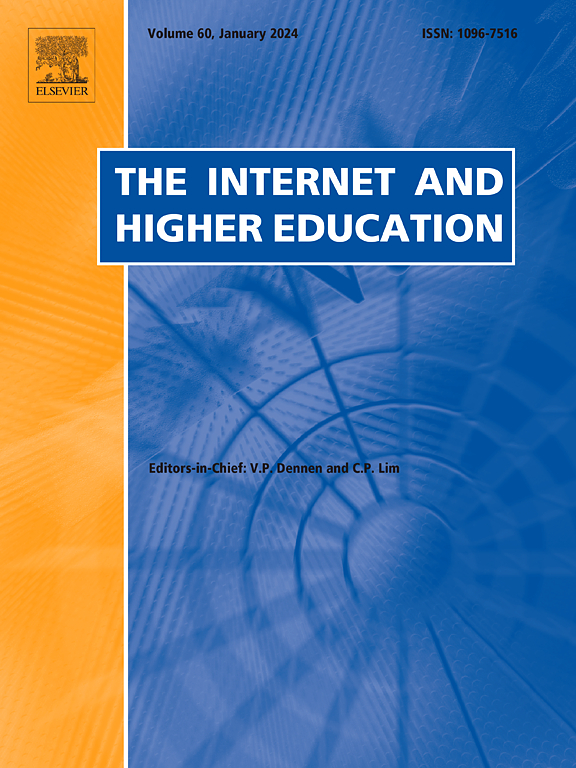Adaptive online course design: Analysis of changes in student behaviour throughout the degree lifecycle
IF 6.8
1区 教育学
Q1 EDUCATION & EDUCATIONAL RESEARCH
引用次数: 0
Abstract
With the growth of the online higher education sector, educational institutions are increasingly creating asynchronous online courses resembling Massive Open Online Courses (MOOCs), characterised by reduced interpersonal interactions. While these courses offer higher flexibility for students, much remains unknown about how the design of these courses impacts student behaviour and performance. This study combines learning analytics and learning design (via Open University Learning Design Initiative (OULDI) taxonomy) to examine effective online course design elements in a 100 % online environment. Effectiveness is evaluated based on the impact of design elements on student engagement and performance. Student engagement patterns throughout the degree are also explored. Results show that while assimilative activities are those most frequently undertaken by students, they rank as fourth in impact on performance. Experiential, interactive/adaptive, and productive activities, though more impactful, are less common and constitute only a fraction of online course design activities. Students were also more likely to engage with videos as opposed to readings, indicating a preference for this type of content in the online learning environment. Furthermore, an inverse correlation was found between students attempting a range of activities, and the need to communicate with staff (i.e., asking for clarification/guidance). Results also identified six types of student engagement patterns, revealing a transition over time towards an assessment focus, where students self-optimise and prioritise assessment completion (over other content/activities). In an online environment, where introducing sequential/scaffolding activities may prove difficult, findings indicate that activities should be clearly linked to assessments to cater for student engagement patterns.
适应性在线课程设计:分析整个学位生命周期中学生行为的变化
随着在线高等教育领域的发展,教育机构越来越多地创建类似大规模在线开放课程(MOOCs)的异步在线课程,其特点是人际互动减少。虽然这些课程为学生提供了更高的灵活性,但这些课程的设计如何影响学生的行为和表现,仍有很多未知之处。这项研究结合了学习分析和学习设计(通过开放大学学习设计倡议(OULDI)分类),在100%的在线环境中检查有效的在线课程设计元素。有效性是根据设计元素对学生参与和表现的影响来评估的。学生在整个学位的参与模式也进行了探讨。结果显示,虽然同化活动是学生最常进行的活动,但它们对成绩的影响排名第四。体验式、互动性/适应性和生产性活动,虽然更有影响力,但不太常见,只占在线课程设计活动的一小部分。与阅读相比,学生们更倾向于观看视频,这表明在在线学习环境中,他们更喜欢这种类型的内容。此外,在尝试一系列活动的学生与需要与工作人员沟通(即要求澄清/指导)之间发现了负相关。结果还确定了六种学生参与模式,揭示了随着时间的推移向评估重点的转变,学生自我优化并优先完成评估(而不是其他内容/活动)。在在线环境中,引入顺序/脚手架活动可能会很困难,研究结果表明,活动应与评估明确联系起来,以满足学生的参与模式。
本文章由计算机程序翻译,如有差异,请以英文原文为准。
求助全文
约1分钟内获得全文
求助全文
来源期刊

Internet and Higher Education
EDUCATION & EDUCATIONAL RESEARCH-
CiteScore
19.30
自引率
4.70%
发文量
30
审稿时长
40 days
期刊介绍:
The Internet and Higher Education is a quarterly peer-reviewed journal focused on contemporary issues and future trends in online learning, teaching, and administration within post-secondary education. It welcomes contributions from diverse academic disciplines worldwide and provides a platform for theory papers, research studies, critical essays, editorials, reviews, case studies, and social commentary.
 求助内容:
求助内容: 应助结果提醒方式:
应助结果提醒方式:


